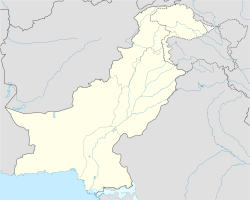Rawat Fort
| Rawat Fort قلعہ روات | |
|---|---|
| Rawat, Pakistan | |
 A view of the fort's main entrance | |
| Site information | |
| Type | Fort |
| Location | |
| Coordinates | 33°29′53″N 73°11′39″E / 33.4981°N 73.1942°E |
Rawat Fort (Urdu: قلعہ روات), also known as Sarai Rawat, is an early 15th century fortified caravanserai on the Pothohar Plateau of Pakistan, near the city of Rawalpindi in the province of Punjab.[1][2]
Location
[edit]It is 17 km east of Rawalpindi on Grand Trunk Road. The second century Manikyala Stupa can be seen from the roof of the fort's mosque. The fort is located approximately 50 miles from the vast Rohtas Fort, which was built by Sher Shah Suri to bring the Pothohar region under his control.
Etymology
[edit]Rawat Fort derives its name from the Arabic word rabat (Arabic: رباط), meaning 'caravanserai', an inn for caravans.[3][4][2]
History
[edit]The Rawat fort or sarai is believed to have been founded as a caravanserai in the 15th century by the Delhi Sultanate. The caravanserai itself may have been built atop a Ghaznavid-era fort that was established in 1036 CE.[5] The caravanserai was then later fortified in the 16th century by the Gakhar clan in order to defend the Pothohar plateau from Sher Shah Suri's forces.[6][7]
Layout
[edit]The fort is almost in square form and has two gates. It measures 93.5 x 106.3 m and covers a courtyard of around 10,000 m2 (2.5 acres).[2] There is an octagonol tomb with a dome measuring 16.6 m in diameter in the fort's inner portion – an area which also contains many graves. The tomb is traditionally believed to belong to Sarang Khan Gakhar, while graves to be of his associates who died fighting along with him against Sher Shah in 1541.[2] Along the perimeter are several small cells, which may have originally been small rooms rented out to itinerant merchants.The west wall of fort contains a mosque with three domes, measuring 29.5 x 12.1 m.[8]
Conservation
[edit]The fort is federally protected as a Cultural Heritage Site of Punjab, and is managed by the Ministry of Information, Broadcasting and National Heritage. In November 2016, a conservation plan was commissioned for preservation of the fort.[9] 50 million rupees were allocated in March 2017 towards the first of two phases of conservation of the Rawat Fort.[10]
Gallery
[edit]-
The caravanserai's eastern gate
-
A view of the fort's mosque
-
Parts of the fort are in a poor state of conservation
-
The tomb of Sarang Khan, a Gakhar chief who died fighting against Sher Shah Suri
-
Rawat Sarai during night
-
A ruined monument
-
Portions of wall
See also
[edit]References
[edit]- ^ Malik, Iftikhar Haider (2006). Culture and Customs of Pakistan. Greenwood Publishing Group. ISBN 9780313331268.
- ^ a b c d "Rawat Fort, Islamabad, Pakistan". Asian Historical Architecture. Retrieved 26 September 2025.
- ^ "The majestic Rawat Fort". Dawn. 17 August 2017. Retrieved 17 June 2017.
- ^ https://shehersaaz.com/the-magnificent-rawat-fort/
- ^ "Historical Rawat Fort needs preservation". Pak Tea house. 16 June 2008. Archived from the original on 30 August 2012. Retrieved 17 June 2017.
he information displayed at Rawat Fort's by archaeology department reveals that it was built in the early 15th century by Salteen-e-Dehli. However there are some contradictions about the historical background of this fort. According to some historians, the fort was built by Sultan Masood, son of Sultan Mehmood Ghaznavi in 1036 AD while some other books of history reveal that Sarang Khan, the leader of Gakhar tribes in Pothohar, built the fort.
- ^ Malik, Iftikhar Haider (2006). Culture and Customs of Pakistan. Greenwood Publishing Group. ISBN 9780313331268.
- ^ "The majestic Rawat Fort". Dawn. 17 August 2017. Retrieved 17 June 2017.
- ^ "The majestic Rawat Fort". Dawn. 17 August 2017. Retrieved 17 June 2017.
- ^ "Work on conservation of Rawat Fort starts". The News. Retrieved 17 June 2017.
- ^ "Rs 50m allocated for renovation of Rawat Fort". Pakistan Today. 5 March 2017. Retrieved 17 June 2017.








